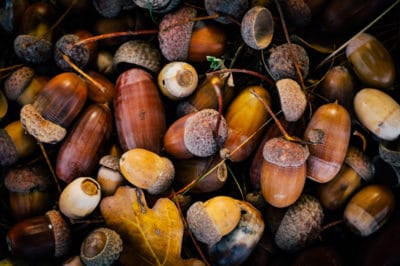Beating the Odds
Mature oak trees produce between 1,000 and 2,000 acorns per crop. Depending on variety, their crops appear every two to 10 years over lifetimes that often span centuries. For some oaks, that can equal hundreds of thousands of acorns per tree. But the 10,000-to-1 odds of any oak seedling surviving to maturity hinge on all the right things happening:
- It escapes being eaten by an animal. Deer are the biggest threat: in autumn, acorns make up to 25 percent of their diet. Blue jays, woodpeckers, ducks and mice also feed on acorns.
- It lands where it can root easily: on tilled soil, inside a fallen log or beneath plant debris on the forest floor.
- It sends a first root deep enough into the soil to provide water. White oak acorns root before winter; red and black oak acorns root the following spring.
- It survives at least 20 years, long enough to its own acorns. This often means battling insects, disease or invasive plants that steal its water, nutrients and sunlight.
Expert gardener’s tip: If you’re planning on growing your own oak trees, be sure to keep the acorns in shade when collecting them. Don’t let them dry out or freeze and plant them as soon as possible.
The Oak Tree ID Challenge
See an oak tree you love, but don’t know its name? Examine its leaves and acorns for clues. Use ripe acorns (not green ones) because their caps twist off easily for inspection.
The Red Oak Group
Trees in this group (which also includes black, blackjack, pin, northern pin and shingle oaks) have bristled or pointed leaf lobes and velvety hairs covering the insides of their acorn caps. They grow in USDA hardiness zones 3 through 9, depending on species. These oaks produce an acorn crop every two to three years.
The White Oak Group
The most common members of this group include white, chinkapin, bur, post and white swamp oaks also found in USDA zones 3 through 9. Their leaves have rounded lobes and the insides of their acorn caps are smooth. These oaks produce many fewer crops than the red oak group, with acorns appearing every four to 10 years.
Narrowing Things Down
Once you’ve identified an oak tree’s group, study its acorns for even more clues to its species. Look at their:
- Shape: Are they round, or nearly so, with blunt bases or more oblong and tapering?
- Color: Ripe acorns range from pale to dark brown to chestnut red or even black. Ignore the greenish or grayish ones, because they’re not ripe.
- Cup scales: Thin and flat or thick and warty scales cover every acorn cup. They provide some of the clearest hints to an oak’s species.
- Nut size: From pin oaks to bur oaks, the sizes of acorn nuts — the parts beneath the cups — vary from miniscule to mammoth. Pin oaks (hardy in USDA zones 4 though 8) produce 3/8- inch nuts, about 1/5 the size of the bur oak’s (USDA zones 3 through 8) impressive 2-inch ones.
Expert gardener’s tip: Whey you’re unraveling the mystery of identity, no tool is more valuable than a field guide to your regional oak trees. it will eliminate hunting through hundreds of species not found locally.
Knowing What Oaks to Grow
By knowing what oaks will grow in your area, you can help the wildlife. Red oak group acorns don’t sprout until spring, so birds and animals cache them. White oak acorns sprout and begin losing nutrients soon after dropping, so they’re usually eaten as soon as they ripen. Plant acorns from both groups to provide the local critters with food from fall through spring.
